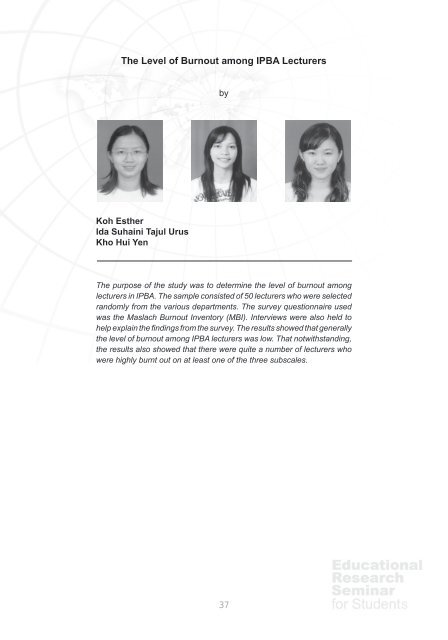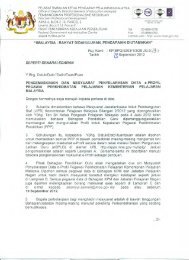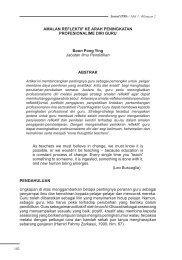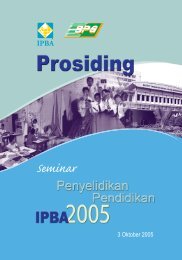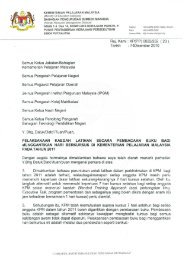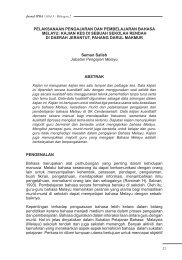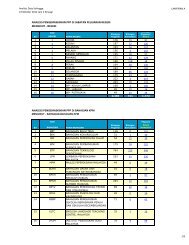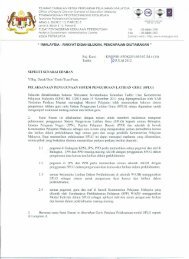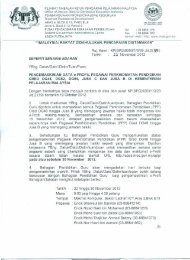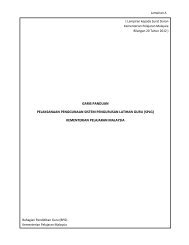The Level of Burnout among IPBA Lecturers
The Level of Burnout among IPBA Lecturers
The Level of Burnout among IPBA Lecturers
You also want an ePaper? Increase the reach of your titles
YUMPU automatically turns print PDFs into web optimized ePapers that Google loves.
<strong>The</strong> <strong>Level</strong> <strong>of</strong> <strong>Burnout</strong> <strong>among</strong> <strong>IPBA</strong> <strong>Lecturers</strong><br />
by<br />
Koh Esther<br />
Ida Suhaini Tajul Urus<br />
Kho Hui Yen<br />
<strong>The</strong> purpose <strong>of</strong> the study was to determine the level <strong>of</strong> burnout <strong>among</strong><br />
lecturers in <strong>IPBA</strong>. <strong>The</strong> sample consisted <strong>of</strong> 50 lecturers who were selected<br />
randomly from the various departments. <strong>The</strong> survey questionnaire used<br />
was the Maslach <strong>Burnout</strong> Inventory (MBI). Interviews were also held to<br />
help explain the findings from the survey. <strong>The</strong> results showed that generally<br />
the level <strong>of</strong> burnout <strong>among</strong> <strong>IPBA</strong> lecturers was low. That notwithstanding,<br />
the results also showed that there were quite a number <strong>of</strong> lecturers who<br />
were highly burnt out on at least one <strong>of</strong> the three subscales.<br />
37
Introduction<br />
<strong>The</strong>re are 94 lecturers currently teaching in the International Languages Teacher Training<br />
Institute (<strong>IPBA</strong>). <strong>The</strong> lecturers come from ten different departments, such as the Social<br />
Studies, Education and the English Language departments. Generally, apart from<br />
conducting lectures, the lecturers also have to do some multi-tasking activities such as<br />
taking charge <strong>of</strong> co-curricular activities, organizing the annual convocation ceremony and<br />
other such activities.<br />
Statement <strong>of</strong> the Problem<br />
In view <strong>of</strong> the heavy workload <strong>of</strong> lecturers, it would not be surprising to find some lecturers<br />
either stressed or burnt out. Obviously, lecturers who are burnt out will not be able to<br />
perform their duties to the best <strong>of</strong> their abilities. Exactly how serious is the situation <strong>among</strong><br />
<strong>IPBA</strong> lecturers? So far, no study has been conducted in this direction.<br />
Research Questions<br />
This study hopes to answer the following questions:<br />
1. What is the level <strong>of</strong> burnout <strong>among</strong> <strong>IPBA</strong> lecturers?<br />
2. Does age, teaching experience, gender and marital status influence the level <strong>of</strong><br />
burnout <strong>among</strong> lecturers?<br />
3. What are some <strong>of</strong> the causes <strong>of</strong> burnout <strong>among</strong> <strong>IPBA</strong> lecturers?<br />
Significance <strong>of</strong> the Study<br />
<strong>The</strong> findings from this study are significant because they can provide valuable information<br />
for both lecturers and administrators on the burnout levels <strong>of</strong> lecturers. By having this<br />
information, lecturers can take steps to avoid aggravating their burnout levels. Administrators<br />
can organize seminars, workshops or other activities that can help lecturers cope with<br />
burnout. <strong>The</strong>y can also take steps to prevent lecturers from being burnt out.<br />
Limitation <strong>of</strong> the Study<br />
This study was limited to <strong>IPBA</strong> lecturers. As such, the findings may not be generalizable to<br />
lecturers in all the teacher training institutes in Malaysia.<br />
Definition <strong>of</strong> Terms<br />
<strong>Burnout</strong><br />
In general, most studies have in some way espoused the combination <strong>of</strong> definitions <strong>of</strong><br />
38
urnout by Farber (1984) and Maslach and Jackson (1981) namely, burnout is the final<br />
step in a progression <strong>of</strong> unsuccessful attempts to cope with negative stress conditions<br />
and that burnout can be seen from three aspects <strong>of</strong> subscales, that <strong>of</strong> emotional<br />
exhaustion, depersonalization and personal accomplishments (Aeria, 1995).<br />
<strong>The</strong> subscale <strong>of</strong> emotional exhaustion burnout refers to feelings <strong>of</strong> physical and<br />
emotional exhaustion and ennui as a result <strong>of</strong> daily work pressures and time constraints.<br />
Depersonalisation burnout occurs as a result <strong>of</strong> the incessant interactions <strong>among</strong> helpers<br />
(for example, lecturers) and clients (for example, students) and this form <strong>of</strong> burnout<br />
is categorized by the development <strong>of</strong> negative attitudes and impersonal responses<br />
towards the people with whom one works closely. Personal accomplishments burnout<br />
indicates a loss <strong>of</strong> self- esteem and work accomplishment as a consequence <strong>of</strong> limited<br />
positive feedback and recognition (Maslach & Jackson, 1981).<br />
<strong>Level</strong> <strong>of</strong> <strong>Burnout</strong><br />
Respondents indicated their level <strong>of</strong> agreement to each <strong>of</strong> the 22 items in the Maslach<br />
<strong>Burnout</strong> Inventory (MBI) based on an 8 point Likert rating scale, a ‘1’ indicates very<br />
mild or untrue while a ‘7’, very strong or true. <strong>The</strong> respondents score ‘0’ (zero) if the<br />
feeling or attitude described is never experienced.<br />
<strong>The</strong> total <strong>of</strong> the scores is then summed up according to the three subscales. <strong>The</strong><br />
level <strong>of</strong> burnout is then determined by the mean obtained for each subscale as shown<br />
in Table 1. <strong>The</strong> range <strong>of</strong> experienced burnout has been categorized following that <strong>of</strong><br />
Aeria’s categorization <strong>of</strong> MBI scores.<br />
Table 1: Categorization <strong>of</strong> MBI mean<br />
Note: Items on personal accomplishment have been reversed-scored<br />
Source: Adapted from Aeria (1995).<br />
As can be seen from Table 1, if a respondent obtained a mean <strong>of</strong> 4.00 or less for the<br />
Emotional Exhaustion (EE) subscale, then he is deemed to experience a low level<br />
<strong>of</strong> burnout. A mean <strong>of</strong> above 4.33 indicates that the respondent experiences a high<br />
burnout level for EE. Note that the means for the range <strong>of</strong> experienced burnout level<br />
varies between the subscales.<br />
39
Methodology<br />
Sample<br />
50 lecturers were randomly selected from the total <strong>of</strong> 94 lecturers. <strong>The</strong> breakdown <strong>of</strong><br />
the number <strong>of</strong> lecturers selected is shown in Table 2.<br />
Table 2: Demographic Data <strong>of</strong> the Sample<br />
Demographic Variable<br />
Frequeuncy<br />
Sample<br />
Percentage (%)<br />
Sex<br />
Male<br />
Female<br />
Age<br />
40 years and below<br />
Above 40 years<br />
Marital Status<br />
Single<br />
Married<br />
Teaching Experience<br />
15 years and below<br />
Above 15 years<br />
Department<br />
English Language Department<br />
Other Department<br />
15<br />
35<br />
25<br />
25<br />
08<br />
42<br />
11<br />
39<br />
25<br />
25<br />
30<br />
70<br />
50<br />
50<br />
16<br />
84<br />
22<br />
78<br />
50<br />
50<br />
Instrument<br />
In order to collect the data for this experiment, a survey questionnaire, MBI, was taken<br />
from Aeria (1995). An interview schedule was also adapted to elicit further information<br />
from the respondents. <strong>The</strong> questionnaire and interview schedule was validated by a<br />
lecturer in <strong>IPBA</strong> so as to ensure that the instrument was appropriate for its purpose.<br />
Data Collection Procedures<br />
Before the MBI was administered to the sample, it was piloted on three lecturers.<br />
<strong>The</strong>se lecturers were asked to comment on the clarity <strong>of</strong> the items and to highlight any<br />
items that they felt were ambiguous. Feedback from the lecturers showed that there<br />
were no items that needed corrections.<br />
After the pilot run, the MBI was administered to the sample. <strong>The</strong> responses to the survey<br />
questionnaire were then analyzed. Based on the analysis, an interview schedule was<br />
developed to elicit further information from the lecturers with respect to the level <strong>of</strong><br />
burnout <strong>among</strong> lecturers.<br />
40
Five lecturers from the sample were selected to be interviewed. <strong>The</strong> responses during<br />
the interview were then analyzed and used to explain the findings from the MBI.<br />
Data Analysis<br />
Table 3 and Figure 1 show the mean level <strong>of</strong> burnout <strong>among</strong> <strong>IPBA</strong> lecturers. From the table<br />
and figure, it can be seen that the mean for the EE, DP and PA subscales are 3.52, 1.76<br />
and 2.04 respectively.<br />
Based on the criteria as shown in Table 1, the results indicate that generally <strong>IPBA</strong> lecturers<br />
experience only a low level <strong>of</strong> burnout in the EE and PA subscales while they face a<br />
moderate level <strong>of</strong> burnout in the DP subscale. This indicates that generally <strong>IPBA</strong> lecturers<br />
experience low levels <strong>of</strong> physical and emotional ennui due to their daily work pressures and<br />
time constraints. Also the results indicate that <strong>IPBA</strong> lecturers generally do not experience<br />
a loss <strong>of</strong> self- esteem and work accomplishment.<br />
Table 3: <strong>The</strong> Mean <strong>of</strong> <strong>Level</strong> <strong>of</strong> <strong>Burnout</strong> <strong>among</strong> <strong>IPBA</strong> <strong>Lecturers</strong><br />
Subscale<br />
Emotional<br />
Exhaustion<br />
Depersonalisation<br />
Personal<br />
Accomplishments<br />
Mean 3.52<br />
1.76<br />
2.04<br />
Figure 1: <strong>The</strong> Mean <strong>of</strong> <strong>Level</strong> <strong>of</strong> <strong>Burnout</strong> <strong>among</strong> <strong>IPBA</strong> <strong>Lecturers</strong><br />
4.00<br />
3.52<br />
Mean<br />
3.00<br />
2.00<br />
1.00<br />
1.76<br />
2.04<br />
0.00<br />
Emotional Exhaustion Depersonalisation Personal<br />
Accomplishments<br />
Subscale<br />
41
While the overall results above indicate that on the whole <strong>IPBA</strong> lecturers have a low level<br />
<strong>of</strong> burnout for the EE and PA subscales and a moderate level for the DP subscale, an<br />
analysis <strong>of</strong> the number <strong>of</strong> individual lecturers experiencing a high level <strong>of</strong> burnout for each<br />
<strong>of</strong> the subscales showed surprising results. Table 4 and Figure 2 show the percentage and<br />
frequency <strong>of</strong> lecturers experiencing low, moderate and high levels <strong>of</strong> burnout.<br />
<strong>The</strong> results show that more than 50% <strong>of</strong> the <strong>IPBA</strong> lecturers experience a low level <strong>of</strong> burnout<br />
for all three subscales and this is consistent with the results in Table 3. However, the results<br />
also show that as many as 38% <strong>of</strong> the lecturers are experiencing a high level <strong>of</strong> burnout<br />
for the EE subscale. This indicates that more than 1 in 3 lecturers are experiencing a high<br />
level <strong>of</strong> physical and emotional ennui. Table 4 also shows that as many as 20% and 32%<br />
<strong>of</strong> the lecturers are experiencing high burnout for the DP and PA subscales respectively.<br />
This indicates that quite a number <strong>of</strong> lecturers have a high tendency to develop impersonal<br />
responses towards students and colleagues. <strong>The</strong> results also indicate that one out <strong>of</strong> three<br />
lecturers feel that they receive limited positive feedback and recognition for their work thus<br />
resulting in a loss <strong>of</strong> self-esteem.<br />
Interviews held with lecturers indicated that one <strong>of</strong> the possible reasons for the surprising<br />
results is that there is an uneven distribution <strong>of</strong> tasks and responsibilities. This could<br />
explain why some lecturers have a low level <strong>of</strong> burnout for all three subscales whereas<br />
others suffer high burnout for at least one <strong>of</strong> the subscales.<br />
Table 4: <strong>The</strong> Frequency <strong>of</strong> <strong>Level</strong> <strong>of</strong> <strong>Burnout</strong> <strong>among</strong> <strong>IPBA</strong> <strong>Lecturers</strong><br />
Subscale<br />
<strong>Level</strong> <strong>of</strong><br />
<strong>Burnout</strong><br />
Emotional<br />
Exhaustion<br />
Depersonalisation<br />
Personal<br />
Accomplishments<br />
Percentage Frequency Percentage Frequency Percentage Frequency<br />
Low<br />
52.00% 26<br />
54.00% 27<br />
68.00% 34<br />
Moderate 10.00% 5 26.00% 13 0.00% 0<br />
High 38.00% 19 20.00% 10 32.00% 16<br />
42
Figure 2: <strong>The</strong> Percentage <strong>of</strong> <strong>Level</strong> <strong>of</strong> <strong>Burnout</strong> <strong>among</strong> <strong>IPBA</strong> <strong>Lecturers</strong><br />
Percentage (%)<br />
80<br />
70<br />
60<br />
50<br />
40<br />
30<br />
20<br />
10<br />
0<br />
52 54<br />
10<br />
38<br />
26<br />
Emotional Exhaustion Depersonalisation Personal<br />
Accomplishments<br />
Subscale<br />
20<br />
68<br />
0<br />
32<br />
Low<br />
Moderate<br />
High<br />
Table 5 and Figure 3 show the level <strong>of</strong> burnout <strong>among</strong> <strong>IPBA</strong> lecturers according to age. As<br />
can be seen, the mean for the lecturers aged 40 and below for the EE subscale is 3.64,<br />
while that for lecturers above 40 is 3.41. <strong>The</strong> results also show that in all three subscales,<br />
the lecturers aged 40 and below had higher means than those aged above 40.<br />
<strong>The</strong> results indicate that the younger lecturers experience a slightly higher burnout level<br />
than the older lecturers for all three subscales. This result is consistent with that <strong>of</strong> previous<br />
studies (McIntyre, 1982; Crane & Iwanicki, 1986) that found burnout is greatest when<br />
people workers, in this case lecturers, are young and is lower for older workers (as cited<br />
in Aeria, 1995).<br />
Table 5 : <strong>The</strong> <strong>Level</strong> <strong>of</strong> <strong>Burnout</strong> <strong>among</strong> <strong>IPBA</strong> <strong>Lecturers</strong> according to Age<br />
Subscale (Mean)<br />
Age<br />
(years)<br />
Emotional<br />
Exhaustion<br />
Depersonalisation<br />
Personal<br />
Accomplishments<br />
40 and below<br />
3.64<br />
1.94<br />
2.15<br />
Above 40 3.41 1.58 1.94<br />
43
Figure 3: <strong>The</strong> <strong>Level</strong> <strong>of</strong> <strong>Burnout</strong> <strong>among</strong> <strong>IPBA</strong> <strong>Lecturers</strong> according to Age<br />
Mean<br />
4.00<br />
3.00<br />
2.00<br />
1.00<br />
0.00<br />
3.64<br />
3.41<br />
1.94<br />
1.58<br />
2.15<br />
1.94<br />
Emotional Exhaustion Depersonalisation Personal<br />
Accomplishments<br />
Subscale<br />
40 yrs & below<br />
Above 40 yrs<br />
Table 6 and Figure 4 show the level <strong>of</strong> burnout <strong>among</strong> <strong>IPBA</strong> lecturers according to teaching<br />
experience. From the table and figure, it can be seen that the mean for lecturers with 15<br />
years <strong>of</strong> teaching experience and below is 3.99 for the EE subscale, which is 0.6 higher<br />
than the mean recorded by the lecturers with above 15 years <strong>of</strong> teaching experience. <strong>The</strong><br />
results also show that the lecturers with lesser teaching experience score higher means in<br />
all three subscales compared to lecturers with longer teaching experience.<br />
<strong>The</strong> results indicate that the newer lecturers experience higher burnout level compared<br />
to the older lecturers. This result is consistent with the results in Table 5 where younger<br />
lecturers, who are also most probably those with lesser teaching experience, suffer higher<br />
burnout compared to the older lecturers. This finding is also consistent with findings from<br />
previous studies (Maslach, 1982b; Crane & Iwanicki, 1986; Pierce & Molloy, 1990) that<br />
found newer lecturers were more likely to experience higher burnout than more experienced<br />
ones.<br />
Table 6: <strong>The</strong> <strong>Level</strong> <strong>of</strong> <strong>Burnout</strong> <strong>among</strong> <strong>IPBA</strong> <strong>Lecturers</strong><br />
according to Teaching Experience<br />
Teaching<br />
Experience<br />
(years)<br />
Emotional<br />
Exhaustion<br />
Subscale (Mean)<br />
Depersonalisation<br />
Personal<br />
Accomplishments<br />
15 and below<br />
3.99<br />
1.80<br />
2.11<br />
Above 15 3.39 1.74 2.02<br />
44
Figure 4: <strong>The</strong> <strong>Level</strong> <strong>of</strong> <strong>Burnout</strong> <strong>among</strong> <strong>IPBA</strong> <strong>Lecturers</strong><br />
according to Teaching Experience<br />
Mean<br />
5.00<br />
4.00<br />
3.00<br />
2.00<br />
1.00<br />
0.00<br />
3.99<br />
3.39<br />
1.80<br />
1.74<br />
2.11<br />
2.02<br />
Emotional Exhaustion Depersonalisation Personal<br />
Accomplishments<br />
Subscale<br />
15 yrs & below<br />
Above 15 yrs<br />
Table 7 and Figure 5 show the level <strong>of</strong> burnout <strong>among</strong> <strong>IPBA</strong> lecturers according to gender.<br />
As can be seen from the table, the mean for female lecturers for the EE subscale is 3.53<br />
while the mean for the male lecturers is 3.52 giving a difference <strong>of</strong> only 0.01 between their<br />
burnout means. <strong>The</strong> results also show that for all three subscales, the difference in mean<br />
<strong>among</strong> the genders is at most 0.06.<br />
<strong>The</strong> results indicate that both genders experienced quite a similar burnout level. This<br />
finding is consistent with that <strong>of</strong> previous studies (Maslach, 1982) which reported men and<br />
women are fairly similar in their experience <strong>of</strong> burnout except that men show slightly more<br />
depersonalization burnout (as cited in Aeria, 1995).<br />
Table 7: <strong>The</strong> <strong>Level</strong> <strong>of</strong> <strong>Burnout</strong> <strong>among</strong> <strong>IPBA</strong> <strong>Lecturers</strong> according to Gender<br />
Subscale (Mean)<br />
Gender<br />
Emotional<br />
Exhaustion<br />
Depersonalisation<br />
Personal<br />
Accomplishments<br />
Female<br />
3.53<br />
1.74<br />
2.05<br />
Male 3.52 1.80 2.03<br />
45
Figure 5: <strong>The</strong> <strong>Level</strong> <strong>of</strong> <strong>Burnout</strong> <strong>among</strong> <strong>IPBA</strong> <strong>Lecturers</strong><br />
according to Gender<br />
4.00<br />
3.53<br />
3.52<br />
Mean<br />
3.00<br />
2.00<br />
1.00<br />
1.74<br />
1.80<br />
2.05<br />
2.03<br />
Female<br />
Male<br />
0.00<br />
Emotional Exhaustion Depersonalisation Personal<br />
Accomplishments<br />
Subscale<br />
Table 8 and Figure 6 show the level <strong>of</strong> burnout <strong>among</strong> <strong>IPBA</strong> lecturers according to marital<br />
status. As can be seen from the table, the married lecturers recorded a mean <strong>of</strong> 3.44 for<br />
the EE subscale while the single lecturers recorded 3.99. <strong>The</strong> results also show that the<br />
means for the single lecturers are higher in all three subscales compared to the married<br />
lecturers.<br />
<strong>The</strong> results indicate that single lecturers experience higher burnout levels compared to<br />
those who are married. This is consistent with previous studies (Mo, 1991; Golembiewski,<br />
Munzenrider & Carter, 1986) that found people workers, in this case lecturers, who are<br />
single, experience more burnout than those who are married.<br />
Table 8: <strong>The</strong> <strong>Level</strong> <strong>of</strong> <strong>Burnout</strong> <strong>among</strong> <strong>IPBA</strong> <strong>Lecturers</strong><br />
according to Marital Status<br />
Subscale (Mean)<br />
Marital<br />
Status<br />
Emotional<br />
Exhaustion<br />
Depersonalisation<br />
Personal<br />
Accomplishments<br />
Married<br />
3.44<br />
1.74<br />
2.00<br />
Single 3.99 1.85 2.25<br />
46
Figure 6: <strong>The</strong> <strong>Level</strong> <strong>of</strong> <strong>Burnout</strong> <strong>among</strong> <strong>IPBA</strong> <strong>Lecturers</strong><br />
according to Marital Status<br />
Mean<br />
5.00<br />
4.00<br />
3.00<br />
2.00<br />
1.00<br />
0.00<br />
3.44<br />
3.99<br />
1.74 1.85<br />
2.00<br />
2.25<br />
Emotional Exhaustion Depersonalisation Personal<br />
Accomplishments<br />
Subscale<br />
Married<br />
Single<br />
Conclusion<br />
<strong>The</strong> findings from this study show that the level <strong>of</strong> burnout <strong>among</strong> <strong>IPBA</strong> lecturers is generally<br />
low. <strong>The</strong> findings also show that although the mean level <strong>of</strong> burnout is low, nonetheless<br />
there are still quite a number <strong>of</strong> lecturers who are highly burnt out on at least one <strong>of</strong> the<br />
three subscales.<br />
<strong>The</strong> results show that the younger lecturers are more burnt out compared to the older<br />
lecturers. This is probably because younger lecturers usually have less experience<br />
in teaching and performing the other tasks required <strong>of</strong> a lecturer. Due to their lack <strong>of</strong><br />
experience, they have insufficient skills to equip themselves in ways <strong>of</strong> coping with their<br />
workload and in their relationship with others.<br />
Implications and Recommendations<br />
Since there are quite a number <strong>of</strong> lecturers who are highly burnt out on one <strong>of</strong> the three<br />
subscales, this implies that there are still some lecturers who are unable to perform their<br />
duties as well as they would like to. Thus, some action should be taken to reduce the<br />
level <strong>of</strong> burnout <strong>among</strong> these lecturers. It is recommended that there should be an equal<br />
distribution <strong>of</strong> work <strong>among</strong> lecturers as supported by most <strong>of</strong> the interview respondents.<br />
Furthermore, it is suggested that attempts be made to teach lecturers techniques in coping<br />
with stress and in coping with work pressure.<br />
47
References<br />
Aeria, L. A. (1995). Teacher burnout in the implementation <strong>of</strong> currucular change in<br />
national secondary schools. Unpublished master’s thesis, University <strong>of</strong> Malaya, Kuala<br />
Lumpur, Malaysia.<br />
Crane, S. J. & Iwanicki, E. F. (1986). Perceived role conflict, role ambiguity and burnout<br />
<strong>among</strong> special education teachers. Remedial and Special Education, 7 (2), 24-31.<br />
Farber, B. A. (1984). Teacher burnout: Assumptions, myths, and issues. Teachers’ College<br />
Record, 86 (2), 321-338.<br />
Golembiewski, R. T., Munzenrider, R. & Carter, D. (1986). Phases <strong>of</strong> progressive burnout<br />
and their worksite covariants: Critical issue in OD research and proxies. <strong>The</strong> Journal <strong>of</strong><br />
Applied Behavioral Science, 19, 461-481.<br />
Maslach, C. & Jackson, S. E. (1981). Maslach <strong>Burnout</strong> Inventory: Manual. Palo Alto, CA:<br />
Consulting Psychologists Press.<br />
Maslach, C. (1982). <strong>Burnout</strong>, the cost <strong>of</strong> caring. Englewood Cliffs, NJ: Prentice-Hall, Inc.<br />
McIntyre, T. (1982). Factors related to burnout: A review <strong>of</strong> research. Paper presented at<br />
the Annual International Convention <strong>of</strong> the Council for Excetional Children, Houston.<br />
Mo, K. W. (1991). Teacher burnout: Relations with stress, personality, and social support.<br />
Educational Journal, 19 (1),3-11.<br />
Pierce, M. B. & Molloy, G. N. (1990). Psychological and biographical differences between<br />
secondary school teachers experiencing high and low levels <strong>of</strong> burnout. British Journal<br />
<strong>of</strong> Educational Psychology, 60, 37-51.<br />
48


